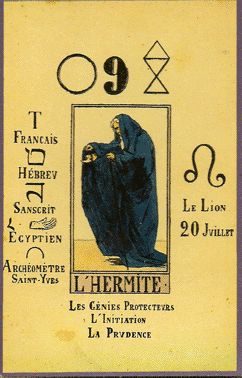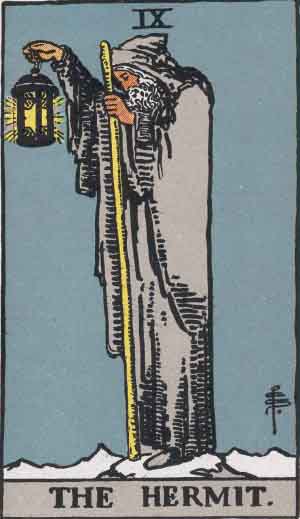Tarot Deep Dive - The Hermit
- Dustin
- Oct 24, 2021
- 5 min read
Updated: Feb 20, 2022
Every card represents an aspect of humanity that has echoed through time. In this series we are going to dive into the history of the imagery found within the tarot, the meaning of the cards and how that meaning changed over time, and the symbols present within the images of what is arguably the most well known tarot deck of all time - the Rider-Waite (Smith) Tarot Deck. So grab your favorite RWS deck, a cup of tea or coffee, and join me live on Sunday mornings over on YouTube as we Deep Dive into each one of the 21 Major Arcana cards continuing now with the antisocial, quirky, nonconformist Hermit.
The Hermit, The Old Man, The Magus of the Voice of Light

The Hermit is a long standing trope in the history of civilization. The slightly socially stunted individual who lives alone on the fringes of society who typically is depicted as knowledgeable in some kind of occult topic and often was only sought out by the socially acceptable out of desperation or fear. They can take the form of a wise old Wizard such as Gandalf, Yoda, or Merlin, or they can have malevolent overtones as The Phantom in Phantom of the Opera or Gollum from Lord of the Rings.
Typically this characters come in two flavors; the helpful anti-social hermit who simply enjoys solitude, or the hostile misanthropic hermit exiled from society. In either of these cases they often are depicted in some sort of spiritual light be it good or evil. These characters are the ones we see our heroes seek out for guidance or training in the case of the Hermit Guru trope as they are often perceived to have gained some great insight from their solitude, and one we see particularly highlighted in the Rider Tarot depiction of The Hermit.
The Fashion of Keeping a Hermit

Interestingly in starting in the late 16th century and rising to wild popularity in the 18th century we saw a trend amongst the wealthy and elite landowners, particularly in western Europe and England, who would build a hermitage or hovel on their estate grounds and employ a person as an ornamental hermit. These aristocrats would host garden parties in which they and their social elite friends could watch and observe the Hermit almost as one would go to see lions in zoo. These employed hermits were required to do things such as not cut their hair or nails, wear rags for clothing, and not speak with anyone. The historian Gordon Campbell describes this trend as “a notion of contemplative solitude and pleasurable melancholy, but it was also a fashion.”
The Hermit Today

In reality and even in modern day Hermits are often associated with religious asceticism, wherein the hermit renounces worldly concerns and pleasures. This can be done for many reasons, including: to come closer to the deity or deities they worship or revere, to devote one's energies to self-liberation. The word hermit comes from the Latin ĕrēmīta, the latinisation of the Greek ἐρημίτης (erēmitēs), "of the desert". In Christian traditions many men who sought an ascetic life would become a hermit, and the Catholic Church even set up communities for them called hermitages where the monks live most of their day and most of their lives in solitary prayer and work, gathering only briefly for communal prayer and only occasionally for community meals and recreation. In the Hindu tradition the Sadhu (male) or Sadhvine (female) are religious ascetics who have renounced the worldly life. Literally, it means one who practices a ″sadhana″ or a deeply disciplined spiritual path.
Visual Evolution
The visual depiction of this arcana is one of the most constant over the evolution of the tarot through time. Depicted as a robed bearded old man facing left with a walking stick and carrying a lantern the visual language of this archetype was well defined by the early Italian decks and we can see that visual language carry straight through to modern day. The only major change was a shift from an hour glass to a lantern that we see in the earliest decks.
Evolution of Meaning
De Mellet (1781): The Old Man.
Levi (1855): he Hebrew letter Teth, the Hermit or Capuchin monk. Goodness, revulsion from evil, morality, wisdom.
Mathers (1888): The Hermit. Prudence, caution, deliberation.
Golden Dawn (1896): The Magus of the Voice of Light, the Prophet of the Gods. The Hermit, or Prophet. Wisdom sought for an obtained from above. In the mystical titles, this with the Hierophant and the Magician are the three Magi.
Waite (1910): The Hermit. Prudence, circumspection. Also treason, roguery, corruption.
Crowley (1944): This card recalls the Legend of Persephone, and herein is a dogma. Concealed within Mercury is a light which pervades all parts of the Universe equally; one of his titles is Psychopompos, the guide of the soul through the lower regions. These symbols are indicated by his Serpent Wand, which is actually growing out of the Abyss, and is the spermatozoon developed as a poison, and manifesting the foetus. Following him is Cerberus, the three-headed Hound of Hell whom he has tamed. In this Trump is shewn the entire mystery of Life in its most secret workings. Yod Phallus Spermatozoon Hand Logos Virgin. There is perfect Identity, not merely Equivalence, of the Extremes, the Manifestation, and the Method.
The Symbols
The Staff

The staff is a symbol of both knowledge, power, and authority. Commonly associated with pilgrims, saints, and prophets such as Moses.
The Lantern & Star

The lantern shines a light on inner truth and wisdom, guiding The Hermit out darkness. The light emanates from a six pointed star. A symbol in alchemy that represents the union of opposites and epitome of as above, so below. Also known as the Seal of Solomon or Star of David the star represents the spiritual power and knowledge The Hermit has.
The Mountain Precipice

Standing at the top of a mountain the hermit has overcome many challenges and has mastered his inner self. Learn more about mountain symbolism in our other blog post here: https://www.modernmetaphysicae.com/post/symbols-in-the-tarot-earth
As always be sure to check out our live discussion on this very topic over on YouTube:
References
Butler, B. Dictionary of the Tarot. New York: Schocken Books, 1986.
Chang, T. Susan. Tarot Correspondences: Ancient Secrets for Everyday Readers. Llewellyn Pulbications, 2018.
Crowley, Aleister (aleister Crowley). Book of Thoth - (Egyptian Tarot). Red Wheel/Weiser, 2017.
Dean, Liz. The Ultimate Guide to Tarot: a Beginners Guide to the Cards, Spreads, and Revealing the Mystery of the Tarot. Fair Winds Press, 2015.
Decker, Ronald; Dummett, Michael. A History of the Occult Tarot. London: Duckworth, 2019.
Fiebig, Johannes, and Evelin Burger. The Ultimate Guide to the Rider Waite Tarot. Llewellyn, 2013.
Huson, Paul. Mystical Origins of the Tarot: From Ancient Roots to Modern Usage. Destiny Books, 2004.
Katz, Marcus. Secrets of the Waite-Smith Tarot: the True Story of the Worlds Most Popular Tarot: with Previously Unseen Photography & Text from Waite & Smith. Llewellyn Publications, 2015.
Waite, A. E. Pictorial Key to the Tarot. Dover Publications Inc, 2005.
Wen, Benebell. Holistic Tarot. North Atlantic Books, 2015.
Images Sourced From: https://en.wikipedia.org/wiki/Wikipedia:Public_domain_image_resources













Comments